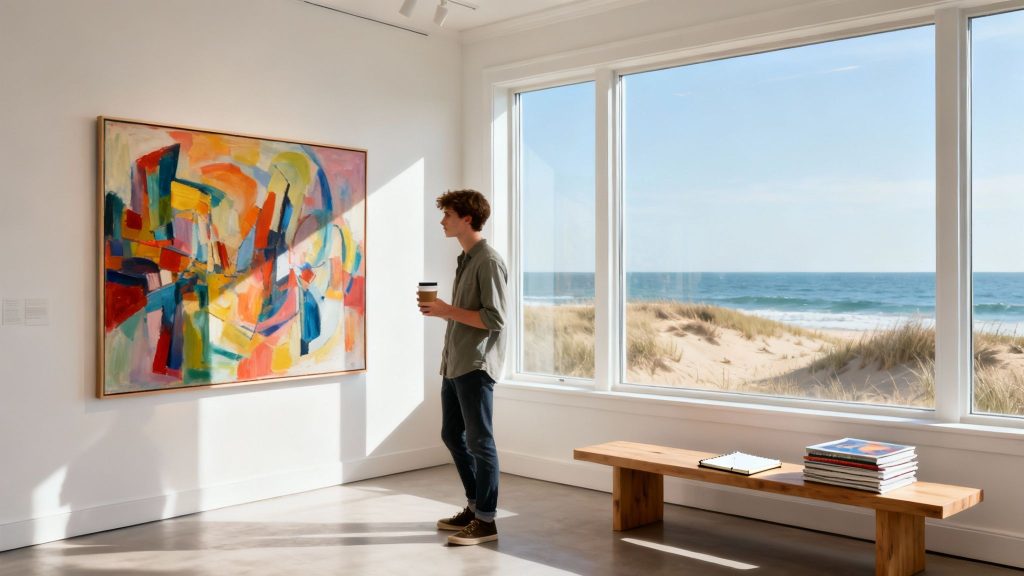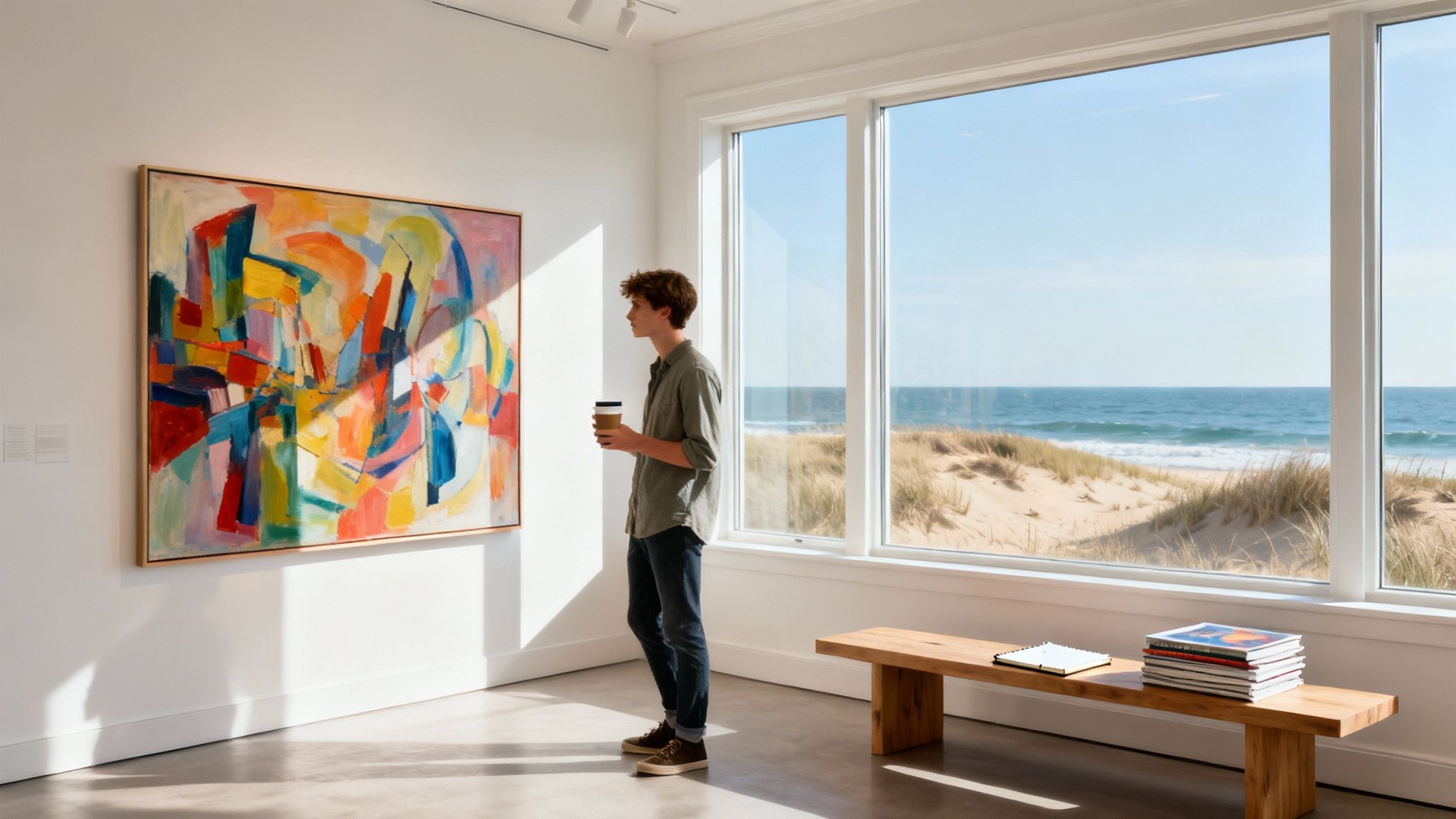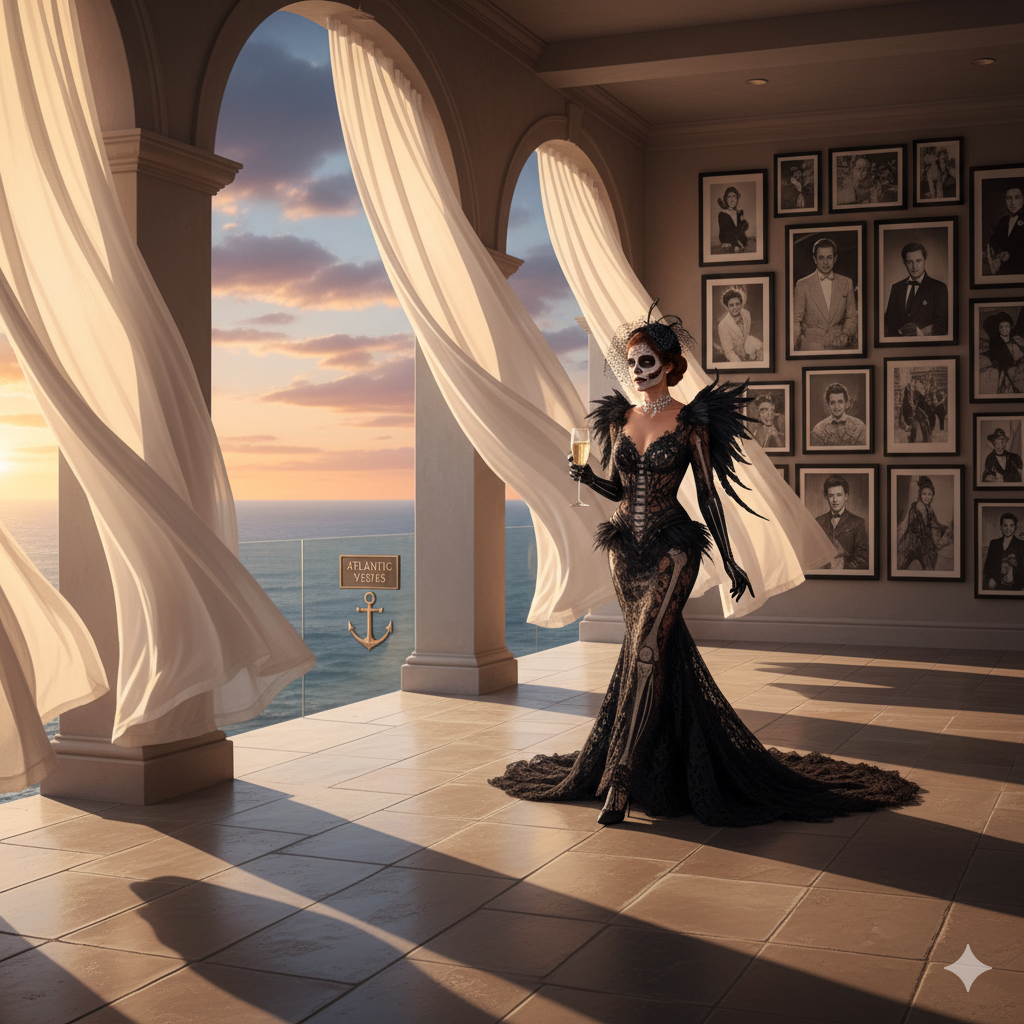Embarking on an art collection is a far more accessible endeavor than many perceive. It is not contingent on vast financial resources or a formal degree in art history; rather, it is about discovering what resonates with you and integrating that beauty into your personal environment. Consider it a sophisticated journey of self-expression, a method for transforming your space into a true reflection of your identity.
Starting Your Art Collecting Journey
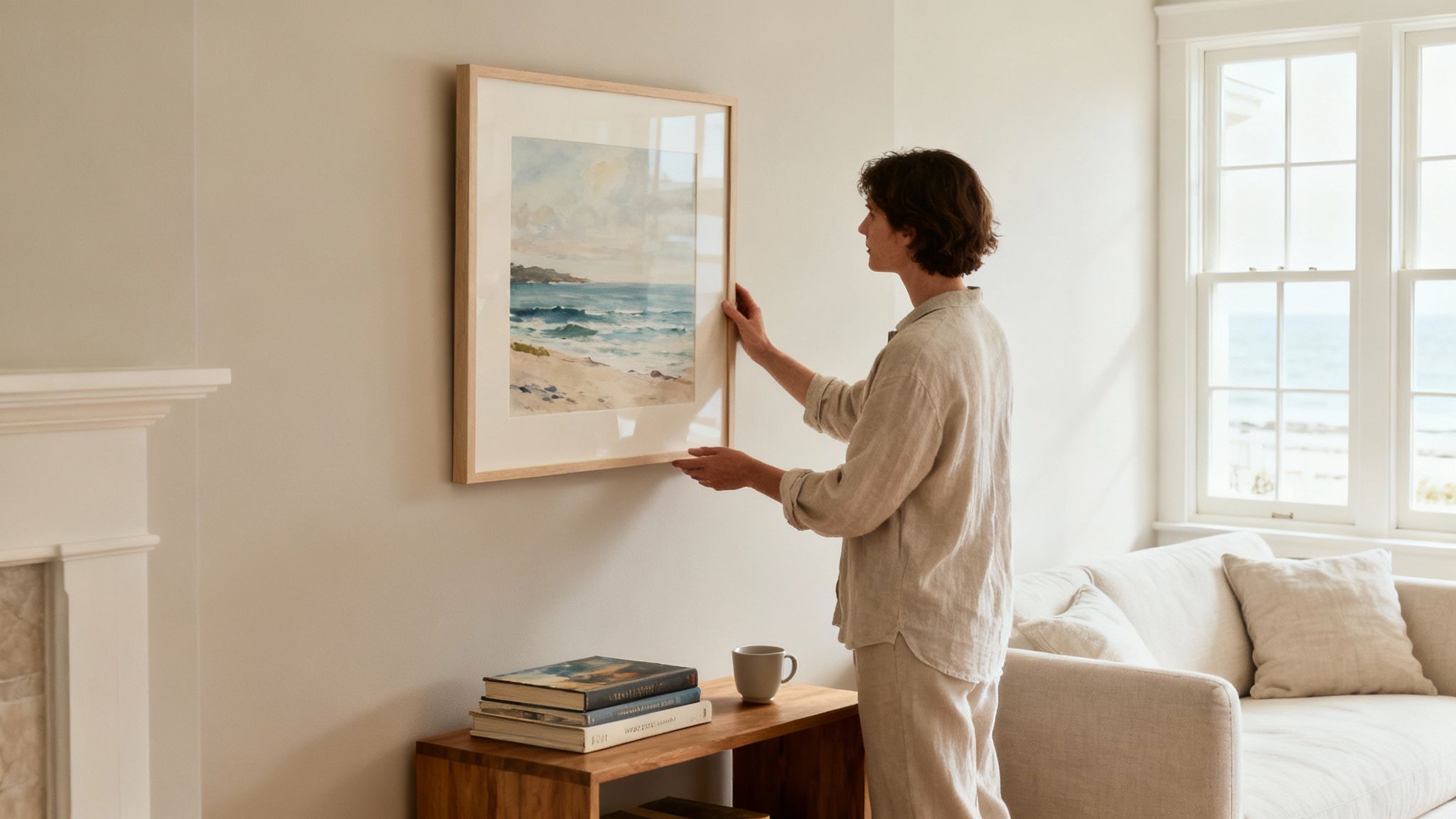
The art world can admittedly feel somewhat intimidating from an external perspective. It is easy to envision high-stakes auctions and formidable price tags. However, that represents only a fraction of the reality.
Today, collecting is a deeply personal journey that begins with a simple question: What moves you?
The reasons individuals collect are as varied as the art itself. For some, it is the sense of joy they experience each time they view a particular piece. For others, it is about curating an atmosphere—adding character and sparking conversation. For a growing number, it is a way to invest in a tangible asset while directly supporting creative talent.
The Modern Shift in Collecting
The art market has become increasingly democratized, making it easier than ever for new enthusiasts to participate. In fact, dealers recently reported that 44% of their buyers were new clients, and sales to first-time collectors rose to 38%. This is not an anomaly; it is a clear signal that collecting is becoming far more accessible.
This transformation is occurring globally, from dynamic online marketplaces to vibrant local scenes in destinations like The Hamptons, where one can engage directly with artists and gallerists. The traditional, exclusive barriers are demonstrably being dismantled.
The most important rule is to acquire what you love. An art collection should be a personal reflection, not a financial spreadsheet. If a piece appreciates in value, that is a benefit—not the primary objective.
Building Your Foundation
You do not need to be an expert to begin, but you do need to be curious. The initial step is simple: view art. A significant amount of it. Visit local galleries, browse online art platforms, and observe what commands your attention. Training your eye is a skill, and learning how to identify valuable antiques can be a valuable starting point, as many core principles of assessing quality and provenance overlap.
Before making your first acquisition, it is beneficial to have a clear roadmap. The foundational pillars have been broken down into a simple kit to help you begin.
Your Art Collecting Starter Kit
This table provides a concise overview of the essential pillars to understand before you make your first art purchase, from defining your purpose to establishing a prudent budget.
| Pillar | Key Action | Why It Matters |
|---|---|---|
| Define Your "Why" | Determine what you seek from your collection. Joy? Investment? Supporting artists? | Your motivation will guide every decision, from the art you choose to the prices you are willing to pay. |
| Set a Realistic Budget | Establish a comfortable spending limit for your first year. | A clear budget prevents overspending and helps you focus your search on attainable pieces. |
| Conduct Your Research | Investigate artists and styles that capture your interest. Follow galleries on social media. | Knowledge builds confidence and helps you identify opportunities you might otherwise miss. |
| Connect with the Scene | Attend local art fairs, gallery openings, and open studio events. | Building relationships provides access to advice, early previews, and a deeper appreciation for the work. |
Mastering these fundamentals will help you transition from a casual admirer to an active, confident participant in the art world. This guide is designed to walk you through the entire process, turning an initial spark of curiosity into a collection you will treasure for years to come.
Discovering Your Taste and Setting a Budget
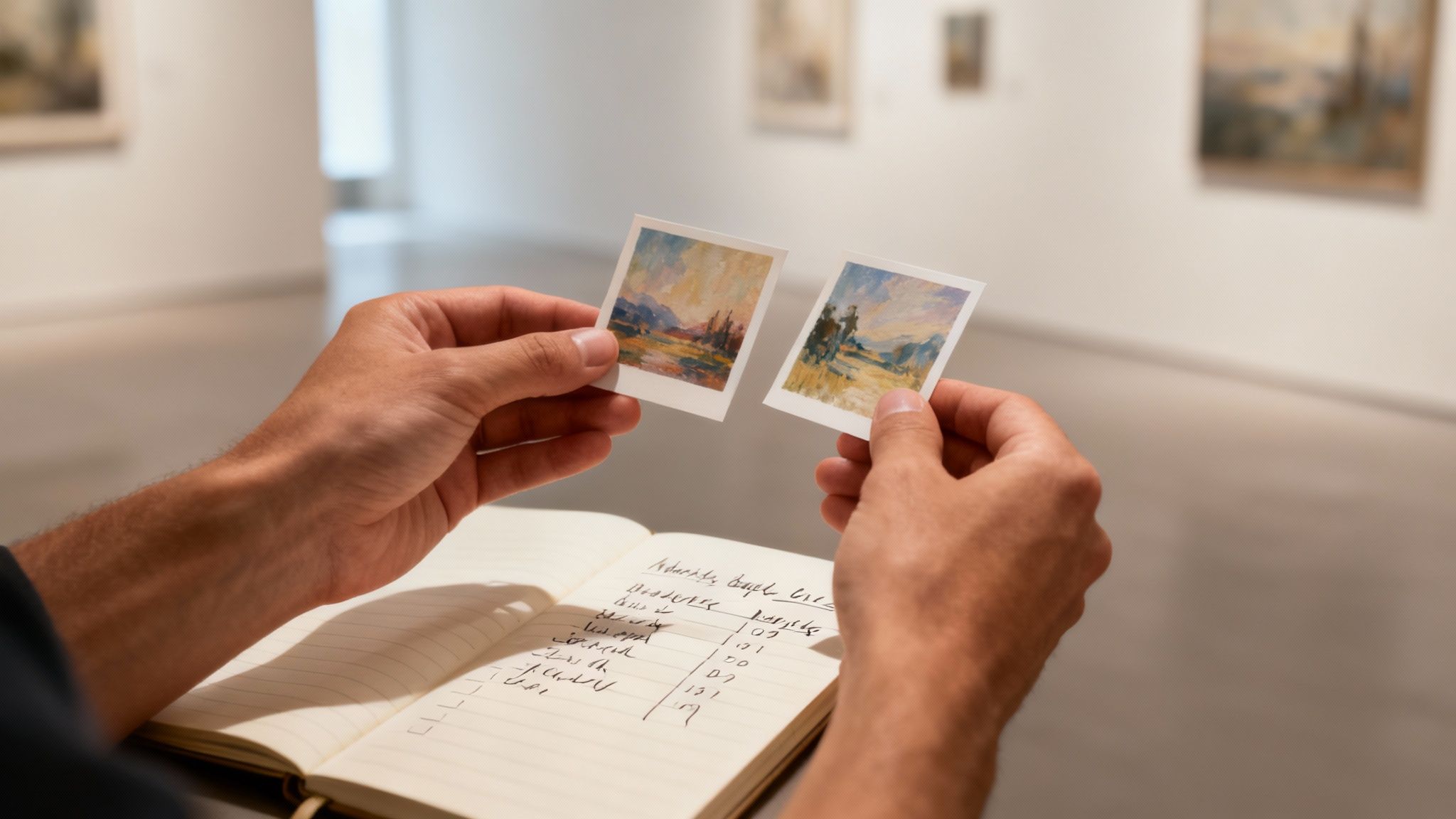
Before you consider acquiring your first piece, the preparatory work begins. This is the most engaging part—discovering what you genuinely love. This process is not about pursuing trends or attempting to predict the art market; it is about connecting with art on a personal level and building a collection that truly speaks to you.
The best way to begin is by looking at art extensively. Dedicate an afternoon to visiting galleries in a culturally rich area like The Hamptons. You will encounter an incredible mix, from contemporary paintings to breathtaking fine art photography. The key is to view everything with intention.
How to Look at Art with Intent
Do not simply walk past a piece. Pause for a moment and allow it to resonate. Ask yourself a few questions to understand what is capturing your eye:
- Your Emotional Response: What is your immediate reaction? Does the work make you feel calm, energized, curious, or even slightly unsettled? This initial feeling is often the most honest indicator of your taste.
- Composition and Color: Notice the way the artist utilizes lines, shapes, and balance. Are you drawn to bold, saturated colors, or do you prefer a more subtle, monochromatic palette?
- Texture and Medium: Consider the materials. Are you captivated by the thick, expressive brushstrokes of an oil painting, the crisp finish of a photograph, or the three-dimensional form of a sculpture?
Engaging in this practice consistently helps you begin to recognize patterns. You might realize you have an affinity for minimalist abstract pieces or that you are drawn to seascapes that evoke a coastal memory.
The connection you build with a piece of art is invaluable. Most seasoned collectors are not engaged in an investment game; they are simply acquiring what they adore.
Setting a Practical Art Budget
Once you have a sense of your aesthetic preferences, it is time to address the financial aspect. This does not need to be a daunting exercise. It is simply about arriving at a figure you are comfortable spending without overextending yourself.
Whether you are starting with a few hundred dollars for a fine limited-edition print or are prepared to invest in a larger original work, having a budget helps narrow your focus. Remember, a high price does not automatically equate to "good" art. There is exceptional work available at every price point.
Accounting for Ancillary Costs
A professional tip many new collectors overlook is that the budget must cover more than the purchase price. Factoring in additional expenses from the outset prevents unwelcome surprises later.
Be sure to account for these common costs:
- Framing: A quality frame not only enhances the art's appearance but also protects it. Professional framing costs can vary significantly depending on the size of the piece and the materials chosen.
- Shipping and Installation: If you acquire a piece from a distant gallery, or if it is a large-scale work, you will need to budget for professional shipping to ensure its safe arrival.
- Insurance: For any significant purchase, it is prudent to add a fine art rider to your homeowner's insurance policy. This protects your new investment against potential theft or damage.
By taking the time to understand your taste and set a clear, all-inclusive budget, you are building a strong foundation for your collecting journey. This thoughtful approach will empower you to buy with confidence and build a collection you will treasure for years to come.
How to Navigate The Hamptons Art Scene
https://www.youtube.com/embed/zlSgHjQ5Kgw
Before you can translate your admiration for art into a tangible collection, you must know where to look. The art world has its own ecosystem, and a vibrant hub like The Hamptons is no exception. Understanding how it operates is the key to confidently making your first acquisition.
At its core, the art market is divided into two distinct arenas: the primary and secondary markets. Each offers a different path for a new collector.
First Stop: The Primary Market
The primary market is where a piece of art is sold for the very first time. For instance, you walk into a gallery in East Hampton and are captivated by a painting. When you purchase it, you are acquiring it directly from the source—the gallery that represents the artist.
For new collectors, this is almost always the ideal place to start. It offers the opportunity to discover and champion emerging artists at the beginning of their careers. The prices are also fixed, eliminating the pressure of a bidding war. More importantly, you can begin to build professional relationships that can last a lifetime.
Your most valuable asset in this world is a strong relationship with a gallerist. They are not merely salespeople. They are deeply passionate advocates for their artists and possess a wealth of knowledge. Never hesitate to initiate a conversation.
What About the Secondary Market?
The secondary market, conversely, deals with art that has been previously owned. This is the domain of local auction houses and private dealers who resell works. Here, prices are determined by supply and demand, which often involves bidding. While it can be exciting, it is also far more unpredictable for a newcomer.
Although you might find more established names on the secondary market, the primary market provides a much more personal and educational entry point into collecting.
Gallery Etiquette (Without Apprehension)
It is understandable that entering a pristine, high-end gallery can feel intimidating. However, it should not. Gallerists genuinely welcome newcomers. If you are unsure how to begin an interaction, here is a simple approach:
- Browsing is Acceptable: A simple "Hello, I'm just looking," is a perfectly normal and acceptable greeting upon entry. Take your time to absorb the exhibition.
- Initiate a Dialogue: When a piece captures your attention, find a gallery associate and say something like, "I'm quite drawn to this piece. Could you tell me more about the artist?"
- Inquiring About Price: This can feel like a delicate subject, but it is a standard business interaction. You can ask directly, "Could you tell me the price of this work?" or, for a more subtle approach, "Is there a price list available for the exhibition?"
Remember, every collector was once a beginner. The art scene in The Hamptons, from its bustling summer art fairs to its quiet year-round exhibitions, thrives on new energy.
The U.S. dominates the global art market, accounting for 45% of all sales, making scenes like this incredibly influential. Once you understand the landscape, you can navigate it with professional poise. You can explore the world's most influential art markets on stronddo.art to gain a broader perspective.
Using Digital Tools to Find Your Next Piece
It is no longer necessary to be in The Hamptons to find incredible art. The art world has expanded its reach far beyond physical gallery walls, giving you a front-row seat to artists, exhibitions, and collections from anywhere in the world. For anyone just beginning, this shift is a significant advantage for art collecting for beginners.
Online platforms and social media are now your most effective tools for discovery. Websites like Artsy, Artnet, and Saatchi Art function as vast, ever-changing galleries at your fingertips, where you can browse thousands of artists. Do not underestimate Instagram—it has become a real-time portfolio for emerging talent, allowing you to follow an artist's creative process as it unfolds.
Navigating the Online Art Market
Acquiring art online is incredibly convenient, but it demands a different kind of focus. You are making a significant investment based on a digital representation, so it is imperative to conduct thorough due diligence to understand the piece remotely.
Here is what you should look for:
- High-Resolution Images: A reputable seller will provide comprehensive visual information—multiple, crisp photographs showing texture, a close-up of the signature, and even an image of the work in a room to provide a true sense of scale.
- Detailed Descriptions: Review this section carefully. Look for precise dimensions, the medium (e.g., oil on canvas, archival pigment print), and any notes regarding its condition.
- Transparent Return Policies: A gallery or platform with a clear, fair return policy demonstrates trustworthiness. It serves as your safety net in the event the artwork does not meet your expectations upon in-person inspection.
The growth in online art sales has been remarkable. Sales nearly doubled between 2019 and 2020 alone, and the digital market has continued its upward trajectory. This expansion has empowered collectors to compare prices and validate an artist's career, lending transparency to a market that once felt opaque. To delve deeper, you can discover more insights about the evolving art world on artfundi.tech.
Vetting Sellers and Ensuring Authenticity
Before committing to a purchase, you must verify both the seller and the artwork. If you are buying from an online gallery, investigate its reputation. How long has it been in operation? Does it have exclusive relationships with its artists? A professional website and positive reviews are always good indicators.
When buying directly from an artist's studio online, look for a consistent exhibition history or representation by a gallery. This provides an external layer of validation and signals a serious commitment to their career.
Crucially, always insist on a Certificate of Authenticity (COA) with your purchase. This official document, signed by the artist or gallery, proves the work is genuine. It is a non-negotiable component of any legitimate art sale and is essential for insurance purposes and the work's future value.
By utilizing these digital tools effectively, you can expand your search far beyond your local scene and build a collection that is truly exciting and diverse.
Making Your First Purchase and Protecting It
You have found it. After extensive searching, learning, and refining your eye, a piece of art has finally captured your full attention. The feeling is one of pure excitement, marking the final step in this initial chapter of your collecting journey. Now, the task is to translate that feeling into a confident, informed purchase and ensure your new treasure is preserved for a lifetime.
Before you finalize the acquisition, a degree of due diligence is prudent. This is not about questioning your intuition for the piece; it is about ensuring the practical details are in order. You will want to understand the artwork’s provenance—its history of ownership. A reputable gallery will have this information readily available, along with a Certificate of Authenticity, and will gladly discuss the artist's exhibition history.
When you are ready to buy, the "where" matters. There are excellent best places to buy art, from well-curated online platforms to exceptional local galleries in destinations like The Hamptons.
Sealing The Deal With Confidence
Purchasing your first piece should be a positive experience, not an overwhelming one. Remember, galleries aim to build long-term relationships with new collectors, not simply make a single sale. Do not hesitate to ask any final questions regarding payment methods, delivery, or even the return policy. Clarifying all terms upfront ensures a smooth, enjoyable process from the gallery wall to yours.
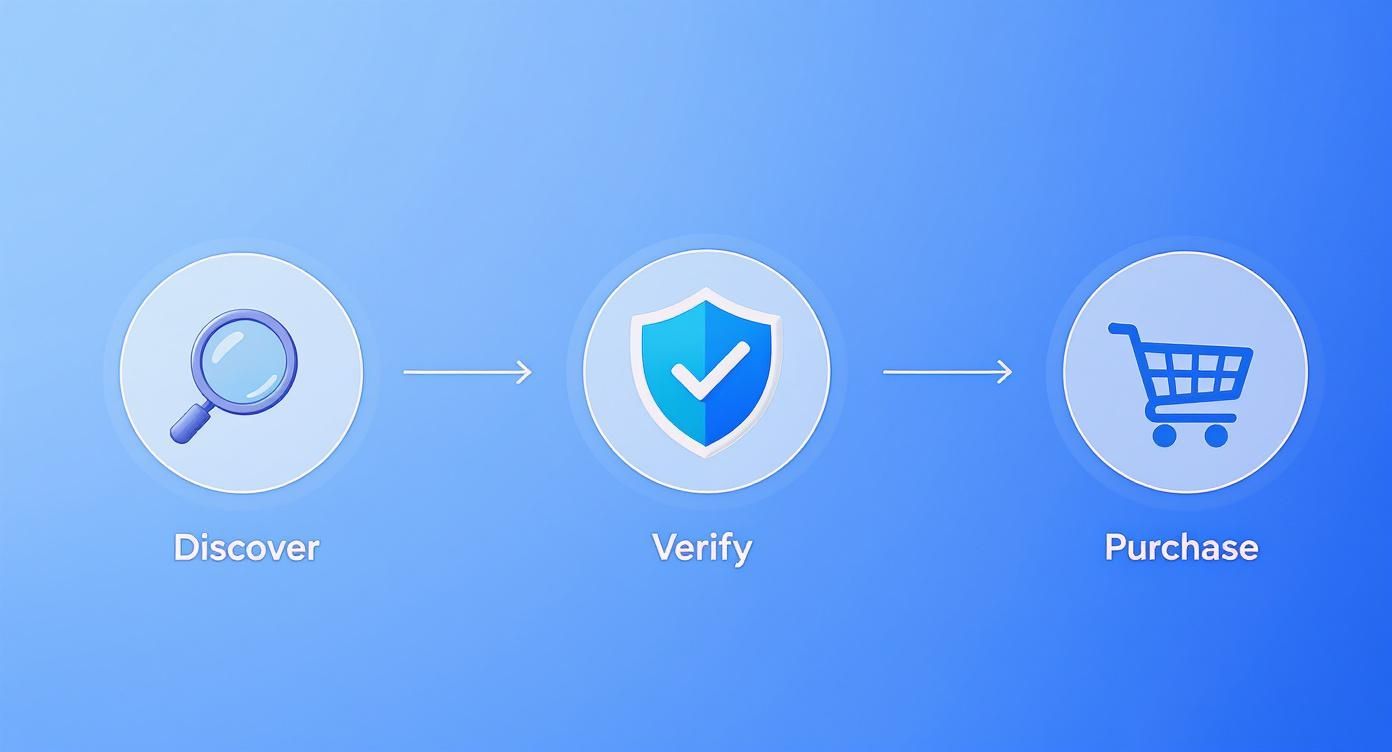
This simple online process illustrates that a successful purchase in art collecting for beginners is ultimately a combination of discovery, careful verification, and a secure transaction.
Protecting Your New Artwork
Once the artwork is yours, your role as its caretaker begins. Proper care is not just about preserving its condition; it is about respecting the artist's work and protecting your investment. This responsibility starts the moment it arrives.
Pro Tip: Retain all documentation related to your new artwork—especially the Certificate of Authenticity and the bill of sale. File them in a secure location. You will need them for insurance and for verifying the piece's history if you ever decide to sell.
The right environment is paramount. Here are a few non-negotiable rules for keeping your art safe at home:
- Mind the Light: Direct sunlight is art's primary adversary. UV rays can fade paintings, prints, and photographs rapidly, and the damage is irreversible. Always choose a location with indirect or controlled lighting.
- Avoid Moisture and Heat: A bathroom or a wall directly above a radiator are unsuitable locations for valuable art. Significant fluctuations in temperature and humidity can cause a canvas to warp, paper to buckle, or even encourage mold growth. A stable environment is key.
- Frame for Protection: A professional frame is more than mere decoration; it is a protective barrier. Consult your framer about using UV-protective glass or acrylic and ensure they use acid-free, archival materials. It is one of the best investments you can make to prevent environmental damage.
Finally, if the piece has significant value, contact your insurance agent. Adding a fine art rider to your homeowner's policy provides peace of mind against theft or accidental damage. Taking these steps ensures that the enjoyment you derive from your first piece will endure for many years to come.
Questions Every New Art Collector Asks
Embarking on your art-collecting journey is exciting, but it is perfectly normal to have numerous questions. Everyone begins somewhere, and most new collectors face similar uncertainties regarding everything from price points to an artist's potential. Let's clarify some of these common inquiries.
Having these initial questions answered will provide the confidence needed to begin making acquisitions and building a collection that is a true reflection of your taste.
What’s a Reasonable Budget for a First Piece?
There is no single correct answer. A good starting point is an amount you feel genuinely comfortable spending, whether that is $300 on a quality limited-edition print or $3,000 on a small original painting. The primary goal is to acquire something you love without financial strain.
Disregard the sensational auction headlines. The world of emerging artists is filled with exceptional work at accessible prices. You can find something that resonates with you without a prohibitive budget.
Gallery vs. Auction: What’s the Difference for a Beginner?
Consider it this way: purchasing from a gallery, particularly in a dynamic scene like The Hamptons, typically means you are the artwork's first owner. It is an excellent way to build relationships with gallerists who can become your guides, introducing you to new talent and sharing the narratives behind the work. Furthermore, prices at a gallery are generally fixed.
Auctions, by contrast, operate in the secondary market—art that is being resold. Prices are determined through competitive bidding, which can be unpredictable. For someone just starting, a gallery offers a more personal, supportive, and educational environment.
The most prudent investment you will ever make is in a piece of art to which you feel a genuine connection. If it appreciates in value over time, consider that a wonderful bonus, not the primary objective.
How Can I Tell if an Emerging Artist is a Smart Buy?
While no one can predict the future, there are certainly positive indicators that suggest an artist is on a strong career trajectory. Obtain their artist CV (their professional résumé) and look for a few key elements:
- Exhibition History: Do they exhibit their work consistently?
- Accolades: Have they earned any awards, grants, or prestigious residencies?
- Representation: Is a reputable gallery actively promoting them and investing in their career?
Ultimately, however, allow your own judgment to be your guide. Your personal connection to the artwork is the most reliable measure of a "good investment," especially when you are just beginning your collection.
Do I Physically Have to Be in The Hamptons to Buy Art There?
Not at all. While there is no substitute for viewing art in person, nearly every Hamptons gallery now maintains a robust online presence. You can browse entire exhibitions on their websites, ask questions via email, and have your new piece securely shipped directly to your location, wherever that may be.
The art world has become increasingly accessible. You can discover and collect pieces from your favorite art hubs without ever leaving home, giving you access to an incredible world of artists.
For more insights into the art, culture, and exclusive events that define upscale living, explore Social Life Magazine. Discover in-depth features on the artists and collectors shaping the scene in The Hamptons and beyond at https://www.sociallifemagazine.com.

